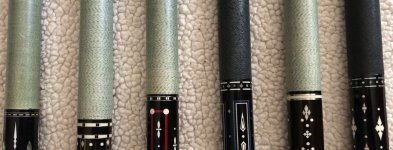Just wondering what cue specs do you prefer? Are you still trying or purchasing cues to find your perfect specs? How long did it take you to come to the conclusion this is what fits my playing style and preferences?
Well It has taken me 30 years to come to a conclusion. I have owned about 50 different cues in my 30 years on the table and have tried numerous other cues that i did not own. So here goes:
I do not like smaller diameter shafts....12.5 mm and up to 13.25. Less error getting off center cueball hit and have better control for position.
I like a longer pro taper than normal.
I do not like 19" or more balance pt. I like to have 17.5" to 18.5"
I like my handle area thinner and i cant lie i don't like big butts. I like smaller diameter butts and like a thinner handle area.
I like cortland linen or irish linen. I love to have my linen sanded super smooth and slicker than a minner lol. Thats why i prefer Cortland because you can get it super smooth.
I never liked longer shafts or cues. I played with standard 58" cues for almost 30 years. I tried couple 57" did not like it for all those years but started shootin with a 57" cue for about a year now. I realized that i now have better cueball control. I dont overrun my position as much.
Pin or joint doesnt make a difference to me. If you blindfold me and hand me cues to hit with im not going to tell you which cue has what pin and joint material.
Oh yeah weight 18 to 18.6 prefered no more than 19.6oz
Well It has taken me 30 years to come to a conclusion. I have owned about 50 different cues in my 30 years on the table and have tried numerous other cues that i did not own. So here goes:
I do not like smaller diameter shafts....12.5 mm and up to 13.25. Less error getting off center cueball hit and have better control for position.
I like a longer pro taper than normal.
I do not like 19" or more balance pt. I like to have 17.5" to 18.5"
I like my handle area thinner and i cant lie i don't like big butts. I like smaller diameter butts and like a thinner handle area.
I like cortland linen or irish linen. I love to have my linen sanded super smooth and slicker than a minner lol. Thats why i prefer Cortland because you can get it super smooth.
I never liked longer shafts or cues. I played with standard 58" cues for almost 30 years. I tried couple 57" did not like it for all those years but started shootin with a 57" cue for about a year now. I realized that i now have better cueball control. I dont overrun my position as much.
Pin or joint doesnt make a difference to me. If you blindfold me and hand me cues to hit with im not going to tell you which cue has what pin and joint material.
Oh yeah weight 18 to 18.6 prefered no more than 19.6oz
Last edited:

